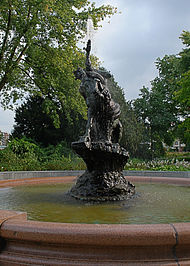Neustadtswallanlagen
| Neustadtswallanlagen | |
|---|---|
| Park in Bremen | |

|
|
| South: Neustadtswallanlagen after Merian (1641) | |
| Basic data | |
| place | Bremen |
| District | Neustadt |
| Created | From 1815 |
| Newly designed | 1891 to 1903 |
| Surrounding streets | Neustadtswall Neustadtscontrescarpe Hohentorstraße Langemarckstr. Friedrich-Ebert-Str . Buntentorsteinweg |
| Buildings | Neustadt barracks , indoor swimming pool south , University of Bremen |
| Technical specifications | |
| Parking area | 16 ha |
The Neustadtswallanlagen are located in Bremen in the Neustadt district , between the Hohentor , Alte Neustadt , Neustadt and Buntentor districts .
history
In 1611, the Dutch Rijswijck student Johan van Valckenburgh (* around 1575, † 1625) worked for the first time and only temporarily as a planner of the fortifications in Bremen . It was not until 1623 that the facilities to the left of the Weser were tackled on the basis of plans by Rijswijck and Valckenburgh. On the Neustadt side there was soon a modern city fortification made of ramparts with eight bastions. When such fortifications made no sense militarily, Bremen decided to decongest it from 1796; Ramps and walls were removed from 1805. The Neustadtswallanlagen should now rather serve as building land. In the western part a simple landscape was created, from which an avenue led parallel to the moat. The remaining areas were leased as garden land. The street names accompanying the system, Neustadtswall (inside) and opposite Neustadtscontrescarpe (outside) are reminiscent of the ramparts.
Since 1815 - in contrast to the Bremer Wallanlagen on the privileged right bank of the Weser - areas have increasingly been used by buildings and traffic areas: The barracks at Hohentor and from 1866 the Neustadt barracks on Neustadtscontrescarpe for the Bremen city military ; it followed u. a. further residential buildings, two schools, a hospital building, the indoor swimming pool south and the extension of the University of Bremen . Due to the oncoming traffic, Neustadtswallanlagen were interrupted several times by wide access roads into the center of Bremen and federal highway 75 . From 1891 to 1903 the city moat was finally filled in, in the area between Schulstrasse and Osterstrasse only around 1911. The Piepe, formerly the Holzhafen, remained as the remainder of the former city moat and today it offers an ideal transition to the dike on the Kleine Weser and Werdersee in the east . Finally, a 16 hectare non-continuous park area remained as a green area.
The value of the green space for the population in Neustadt was only recognized later. The Hohentorspark , part of Neustadtswallanlagen, was laid out in 1951/52 on a wasteland and renovated in 2012. The centaurs fountain made of bronze by August Sommer stood on Schwachhauser Heerstrasse in 1891 . In 1958 he was moved to the green area near Leibnizplatz .
The environmental operating Bremen took from 1998 to 2007 in four sections an extensive renovation of the park in front. The width of the park could be emphasized by more generous open spaces. Centaurenbrunnen and Justitia am Hohentor were better integrated as monuments. The now inviting entrance areas offer more views and therefore more security. The leisure activities with the nature and water playground, the youth field and the basketball and streetball field as well as the network of paths improved.
literature
- Peter Schulz, Peter Fischer (cards): Parks in Bremen . Bremer Marketing (ed.), Bremen 2008.
